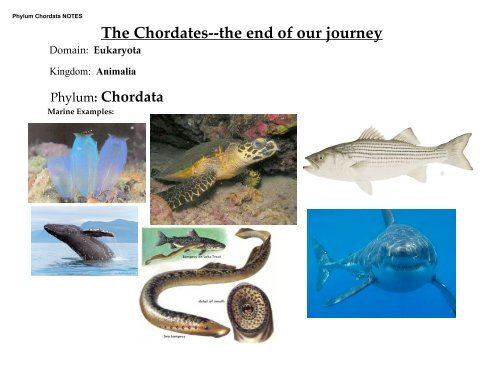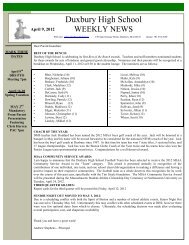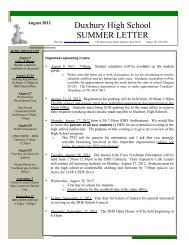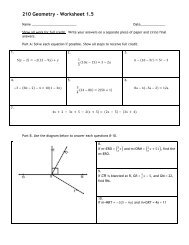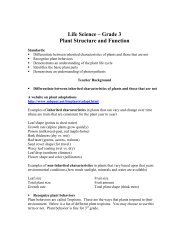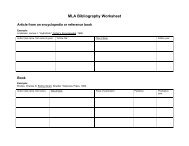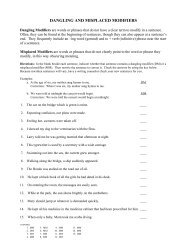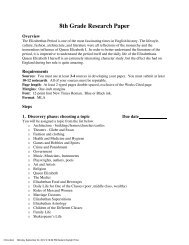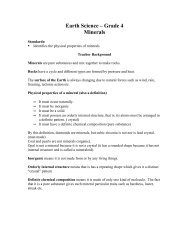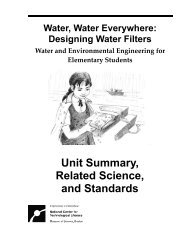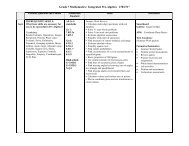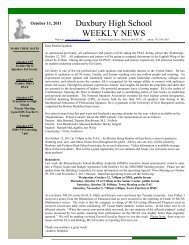Phylum Chordata NOTES April 26, 2012
Phylum Chordata NOTES April 26, 2012
Phylum Chordata NOTES April 26, 2012
You also want an ePaper? Increase the reach of your titles
YUMPU automatically turns print PDFs into web optimized ePapers that Google loves.
<strong>Phylum</strong> <strong>Chordata</strong> <strong>NOTES</strong><br />
The Chordates--the end of our journey<br />
Domain: Eukaryota<br />
Kingdom: Animalia<br />
<strong>Phylum</strong>: <strong>Chordata</strong><br />
Marine Examples:
<strong>Phylum</strong> <strong>Chordata</strong> <strong>NOTES</strong><br />
Also a<br />
Chordate?!?!?!
<strong>Phylum</strong> <strong>Chordata</strong> <strong>NOTES</strong><br />
**Three distinct characteristics define this phylum***<br />
Chordates have these 3 characteristics at some point during their life.<br />
1. Notochord<br />
2. Gill slits<br />
3. Dorsal, hollow Nerve Cord<br />
*Sometimes during the larval or embryo stage can have a post anal<br />
tail.<br />
*All have a ventral heart
<strong>Phylum</strong> <strong>Chordata</strong> <strong>NOTES</strong><br />
Links between invertebrate echinoderms and chordates:<br />
<strong>Phylum</strong> Hemichordate- Acorn Worm<br />
<strong>Phylum</strong><br />
<strong>Chordata</strong><br />
*Share several features related to the development of the embryos.<br />
*The <strong>Phylum</strong> Hemichordata (which we do not discuss) appears to link<br />
the echinoderm and chordate phyla.<br />
*Hemichordate larvae are similar to some echinoderms but share<br />
some characteristics with chordates (dorsal, sometimes hollow nerve<br />
cord, gill slits).
<strong>Phylum</strong> <strong>Chordata</strong> <strong>NOTES</strong><br />
Invertebrate Chordates:<br />
*Not all chordates possess a backbone. A backbone is not a major characteristic of this<br />
phylum.<br />
"All vertebrates are chordates, but not all chordates are vertebrates"<br />
*There are 2 subphyla of invertebrate chordates:<br />
Sea squirt.mp4<br />
Subphylum Urochordate Ex. tunicates, sea squirts<br />
--1,400 species<br />
--Most sessile as adults<br />
(docks, boats, etc.)<br />
--How do they feed?<br />
--Planktonic larval stage (look like a tadpole)<br />
+larval stage does not feed. Locates surface to settle.<br />
+larva undergoes a “spectacular” metamorphosis.
<strong>Phylum</strong> <strong>Chordata</strong> <strong>NOTES</strong><br />
Subphylum Cephalochordata<br />
Ex. Lancelets (Amphioxus)<br />
--29 species<br />
--Looks fish-like but does not<br />
have a backbone. (7 cm in length)<br />
--Benthic. Found in soft bottoms.<br />
--How do they feed?
<strong>Phylum</strong> <strong>Chordata</strong> <strong>NOTES</strong><br />
<strong>Phylum</strong> <strong>Chordata</strong><br />
Subphylum Vertebrata<br />
Vertebrate Characteristics:<br />
*approx. 52,000 species<br />
*Posses a vertebrae.<br />
Define:<br />
--What do the vertebrae enclose and protect?<br />
*Symmetry?<br />
*Type of skeleton?<br />
--What other phylum had the same type of skeleton?<br />
*Closed Circulatory System
<strong>Phylum</strong> <strong>Chordata</strong> <strong>NOTES</strong><br />
*Nervous system characteristics:<br />
* Both external fertilization and internal fertilization are seen in this<br />
<strong>Phylum</strong>.<br />
*Both external development and internal development are seen in this<br />
<strong>Phylum</strong>.
<strong>Phylum</strong> <strong>Chordata</strong> <strong>NOTES</strong><br />
**The Subphylum Vertebrata has 7 classes<br />
CLASS NAME<br />
1. Class Agnatha<br />
2. Class Chondricthyes
<strong>Phylum</strong> <strong>Chordata</strong> <strong>NOTES</strong><br />
3. Class Osteicthyes<br />
--What is the swim bladder?
<strong>Phylum</strong> <strong>Chordata</strong> <strong>NOTES</strong><br />
4. Class Amphibia<br />
5. Class Reptilia<br />
Define Ectotherm (poikilotherm).<br />
AKA: cold-blooded
<strong>Phylum</strong> <strong>Chordata</strong> <strong>NOTES</strong><br />
6. Class Aves<br />
Feathers<br />
Define Endotherm (homeotherm)?<br />
AKA: warm-blooded
<strong>Phylum</strong> <strong>Chordata</strong> <strong>NOTES</strong><br />
7. Class Mammalia


